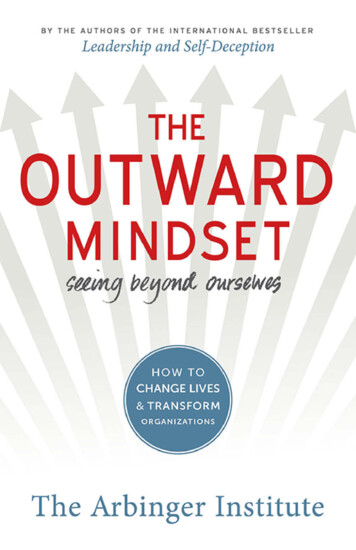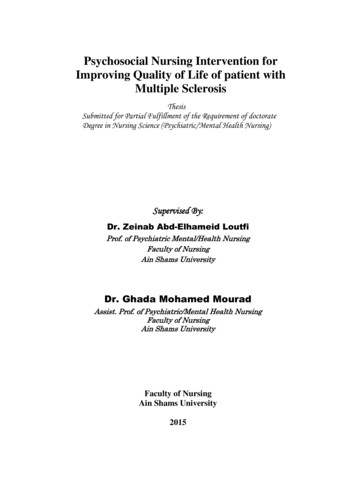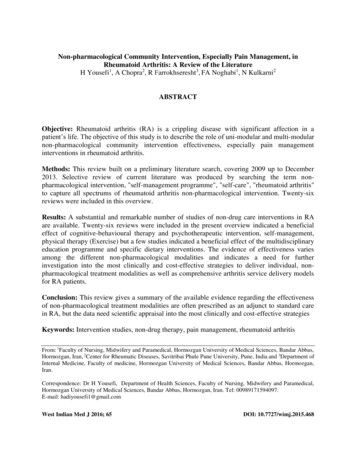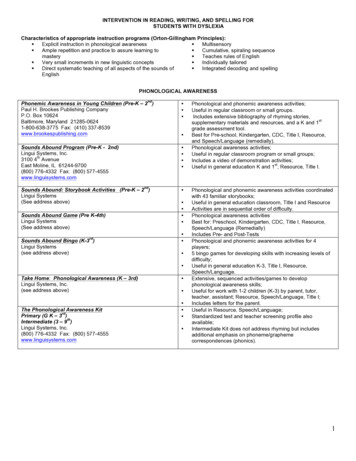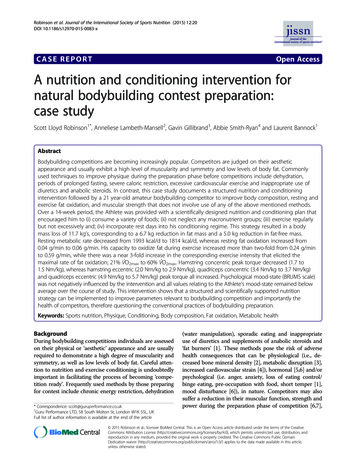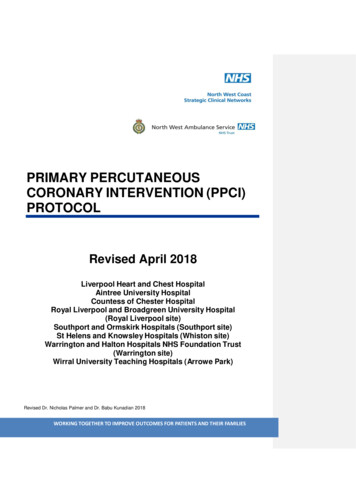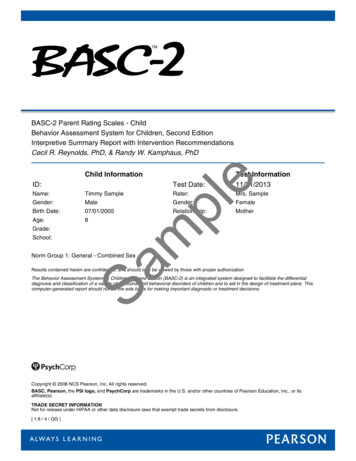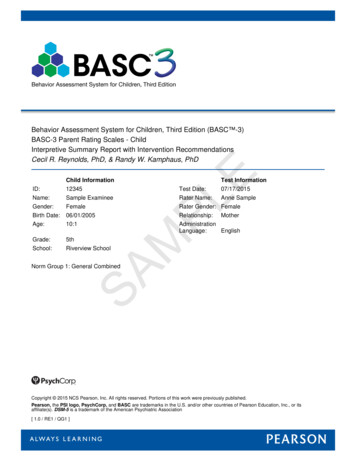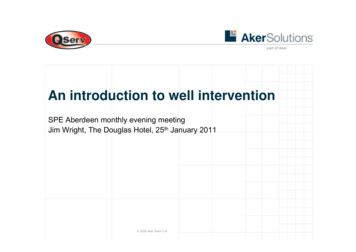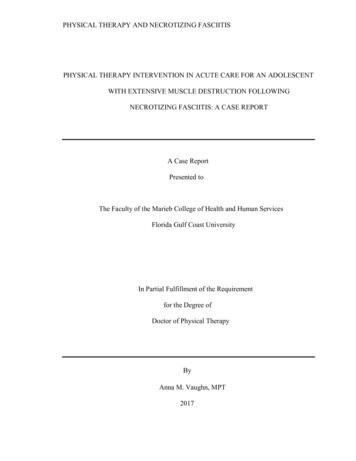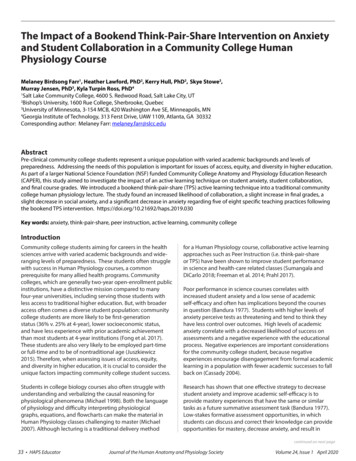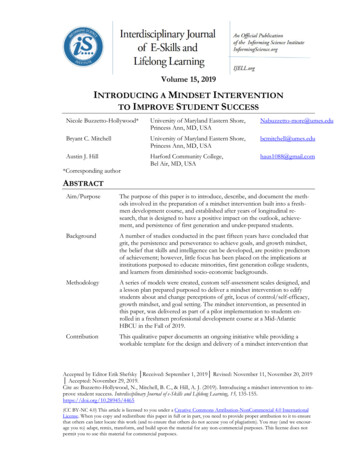
Transcription
Volume 15, 2019INTRODUCING A MINDSET INTERVENTIONTO IMPROVE STUDENT SUCCESSNicole Buzzetto-Hollywood*University of Maryland Eastern Shore,Princess Ann, MD, USANabuzzetto-more@umes.eduBryant C. MitchellUniversity of Maryland Eastern Shore,Princess Ann, MD, USAbcmitchell@umes.eduAustin J. HillHarford Community College,Bel Air, MD, USAhaus1088@gmail.com*Corresponding authorABSTRACTAim/PurposeThe purpose of this paper is to introduce, describe, and document the methods involved in the preparation of a mindset intervention built into a freshmen development course, and established after years of longitudinal research, that is designed to have a positive impact on the outlook, achievement, and persistence of first generation and under-prepared students.BackgroundA number of studies conducted in the past fifteen years have concluded thatgrit, the persistence and perseverance to achieve goals, and growth mindset,the belief that skills and intelligence can be developed, are positive predictorsof achievement; however, little focus has been placed on the implications atinstitutions purposed to educate minorities, first generation college students,and learners from diminished socio-economic backgrounds.MethodologyA series of models were created, custom self-assessment scales designed, anda lesson plan prepared purposed to deliver a mindset intervention to edifystudents about and change perceptions of grit, locus of control/self-efficacy,growth mindset, and goal setting. The mindset intervention, as presented inthis paper, was delivered as part of a pilot implementation to students enrolled in a freshmen professional development course at a Mid-AtlanticHBCU in the Fall of 2019.ContributionThis qualitative paper documents an ongoing initiative while providing aworkable template for the design and delivery of a mindset intervention thatAccepted by Editor Erik Shefsky Received: September 1, 2019 Revised: November 11, November 20, 2019 Accepted: November 29, 2019.Cite as: Buzzetto-Hollywood, N., Mitchell, B. C., & Hill, A. J. (2019). Introducing a mindset intervention to improve student success. Interdisciplinary Journal of e-Skills and Lifelong Learning, 15, 135-155.https://doi.org/10.28945/4465(CC BY-NC 4.0) This article is licensed to you under a Creative Commons Attribution-NonCommercial 4.0 InternationalLicense. When you copy and redistribute this paper in full or in part, you need to provide proper attribution to it to ensurethat others can later locate this work (and to ensure that others do not accuse you of plagiarism). You may (and we encourage you to) adapt, remix, transform, and build upon the material for any non-commercial purposes. This license does notpermit you to use this material for commercial purposes.
Introducing a Mindset Interventionis believed will be highly effective with first generation and socio-economically disadvantaged learners. It represents the third paper in a five paper series.Recommendationsfor PractitionersAs part of a commitment to positive student outcomes, faculty and administrators in higher education must be constantly exploring factors that may, ormay not, impact student success.Recommendationsfor ResearchersResearch is needed that explores elements that may help to contribute to thesuccess of under prepared college students, in particular those who are fromlow income, first generation, and minority groupsFuture ResearchThe authors have introduced the mindset intervention with freshmen business students enrolled in a required professional development course. Resultsof the self-assessments and reflection questions are being collected andcoded. Additionally, students are being administered a survey designed tomeasure the perceived efficacy of the initiative.Keywordsgrit, growth mindset, mindset intervention, self-efficacy, social cognitive theory, learning intervention, student retention, student success, business education, first generation college students, HBCU, minority learners, UMES, University of Maryland Eastern Shore, learning self-efficacy, goal setting, grit ineducationINTRODUCTIONSuccess is much more than simply talent meeting opportunity. Rather, self-regulation, resilience, andmindset play a major role in determining ones achievement (Buzzetto-Hollywood, Quinn, Wang, &Hill, 2019). According to Burgoyne, Hambrick, Moser, and Burt (2018), “mindset refers to a person’sbeliefs about the nature of their abilities—whether they believe their ability in a given domain is malleable or fixed.” (p.21)The concept of growth mindset is most commonly associated with the work of Stanford UniversityProfessor Carol Dweck (2018), who explains that growth mindset is the belief that cognitive capabilities are not permanent but rather can be developed through hard work and dedication. An individualwho possesses a growth mindset thrives on challenges and looks upon failures as learning opportunities from which one gains valuable feedback to help one continue on their journey forward to success. The opposite of a growth mindset is a fixed mindset, the belief that talent is set and unchangingand cannot be improved with practice and dedication. A person with a fixed mindset prioritizes success, is risk averse, and is derailed by setbacks.Since growth mindset is anchored in the confidence one has in one’s own personal development,having a growth mindset requires that one has positive self-efficacy. Self-efficacy is a concept that refers to the confidence that one has in one’s innate ability to achieve goals. Self-efficacy was introduced by Albert Bandura (1977) and lies at the center of his social cognitive theory which posits thatlearning occurs in a social context that involves a dynamic and reciprocal interplay between the person, their environment, and their behaviors. Self-efficacy comes into play with the idea that the levelof a person’s confidence in his or her ability to successfully perform a behavior has a direct impacton one’s goal achievement.Findings have consistently shown that self-efficacy beliefs and mindset have a major influence onstudent success, impacting how a learner experiences and responds to learning situations and setbacks (Passarelli, 2014; Vuong, Brown-Welty, & Tracz, 2010). As such, in recent years the concept of136
Buzzetto-Hollywood, Mitchell, & Hillintroducing interventions purposed to improve mindset and self-efficacy have been growing in popularity. But, what is a mindset intervention? There are no firm definitions of a mindset intervention;however, Passarelli (2014) explains:“Interventions are not complicated. They can be as simple and low-cost as changing the kindof encouragement the student receives in an online lesson, or giving them a one-hour session on how effort and struggle increase academic capabilities.”The goal of any mindset intervention is to improve a student’s frame of mind and therefore increaselearning, and the evidence indicating efficacy of mindset interventions is strong (Dweck, 2018; Pasarelli, 2014). Studies have found that mindset interventions are successful at increasing the grit (persistence and resilience to achieve goals) and academic performance of students (DeBacker et al.,2016; Dweck, 2018) and that they are also particularly effective with students from traditionally underserved groups (Claro, Paunesku, & Dweck, 2016). Accordingly, there is a small, but growing,number of minority serving institutions that are exploring the incorporation of mindset interventionsas part of the total student experience.The following paper will focus on the preparation of a mindset intervention established after years oflongitudinal research that is purposed to have a positive impact on the outlook, achievement, andpersistence of first generation and under-prepared students. The sections of the remainder of the paper are as follows: background, literature review, methodology, mindset intervention discussion, andconclusion and future work. This qualitative paper documents an ongoing initiative and representsthe third paper in a five paper series.BACKGROUNDSince, the initiative presented in this paper is contextualized at a Historically Black College or University (HBCU) it is essential to provide relevant information about HBCUs, the institution in question,and prior research conducted at said institution that inspired the effort under discussion. In manyways HBCUs are uniquely American institutions that are representative of a legacy of systematic oppression of marginalized groups. Founded during a time of forced segregation, for over 100 yearsHistorically Black Colleges and Universities have existed to provide educational opportunities to students who might be otherwise disregarded (Buzzetto-Hollywood and Mitchell, 2019; Schexnider,2017). Currently, there are 101 accredited HBCUs educating nearly 300,000 students (Buzzetto-Hollywood & Mitchell, 2019). As institutions of higher education, HBCUs are found to provide deeplysupportive educational environments that are unparalleled elsewhere in the United States, with Blackgraduates of HBCUs more likely than Black graduates of majority serving institutions to be thriving(Buzzetto-More & Mitchell, 2009; Buzzetto-More & Ukoha, 2009; Seymour & Ray, 2015).HBCUs have as their missions to engage and uplift students who are often marginalized (Lomax,2006; Seymour & Ray, 2015). Gregory Clay of The Undefeated points out that this is because“HBCUs operate with a special mission in mind and a higher cause” as they seek to elevate and improve traditionally underserved communities (Clay, 2016). While the original challenges that existedduring reconstruction and Jim Crow no longer exist, new educational inequities present themselves attoday’s HBCUs, which impact students coming from historically marginalized communities(Buzzetto-Hollywood, Wang, Elobeid, & Elobeid, 2018; Lomax, 2006)Established in 1886, the University of Maryland Eastern Shore (UMES) is a Historically Black, 1890land grant institution. It is a member of the University system of the State of Maryland and primarilyserves first generation, low income, and minority learners (Buzzetto-More, 2015). The student population is approximately 3400, as of the fall of 2016, with a student body that is 78% African American, 9.6% White, 1.4% Hispanic, and 11% international. The gender distribution of the University is64% female and 36% male. The freshmen-to-sophomore retention rate is 71%, and the graduationrate is 41%. The student to faculty ratio is 15 to 1 and 85% of students receive financial aid. UMESwas ranked in the top 20 among Historically Black Colleges and Universities (HBCU) in 2018 and137
Introducing a Mindset Intervention2019 and the acceptance rate for applying students is 62.4% with the majority of students comingfrom the Mid-Atlantic region (Buzzetto-Hollywood et al., 2018). UMES has a long history of providing academic programs and services for ethnically and culturally diverse students and toward thatend, offers programs and assistance that attract, serve, retain, and graduate many first-generation college students.The UMES Department of Business, Management, and Accounting (DBMA) is accredited by the Association to Advance Collegiate Schools of Business (AACSB) International. The Department offersa range of programs including business administration, accounting, marketing, finance, and businesseducation. Additionally, certificate programs in business, marketing, and financial analytics were recently approved. The Department has an Assurance of Learning Committee that is purposed to continuously explore student learning outcomes through meaningful assessment, explore factors impacting the student experience, identify mechanisms through which teaching and learning can be approved, and promote innovative teaching strategies.With an active commitment to student success, a series of studies were undertaken in the UMESDBMA. In the first study (Buzzetto-Hollywood et al., 2019), students were administered the standard12-Question Grit Scale, developed by the team at the UPENN Character Lab, with the addition of aseries of validated questions that sought to measure perceived self-learning efficacy. Additionally, student performances in online courses were recorded and correlations conducted. Basic statistical analyses such as mean, mode, standard deviation, variance, and confidence interval were calculated. Twohypotheses were introduced as part of this study and tested with Anovas and cross tabulations. Thestudy found that higher grit scores correlated progressively to both self-discipline and self-efficacybut that a positive relationship to student achievement in fully online courses as measured with a pvalue of greater than .05 could not be confirmed.The second study (Buzzetto-Hollywood & Mitchell, 2019) examined whether grit was a contributingfactor to student persistence and success at minority serving institutions. The research study was initiated in the Fall of 2014 with the administration of the standard 12-item Grit assessment to all freshmen students enrolled in the business department. Students were then followed longitudinally over afive year period with GPA and persistence to graduation documented. During the analyses, grit scorewas compared to participant first year GPA’s as well as retention and persistence to graduation viacomparison tables and ANOVAs. According to the findings, there is a significant positive correlationbetween higher grit scores and both GPA and persistence to graduation. First year GPA, however,was not found to be a reliable predictor of academic success.Following a thoughtful review of the results of both studies, it was concluded that grit alone mightnot be enough and that in order to have a significant impact on student success a change in mindsetmay be in order. This qualitative paper documents an ongoing initiative by introducing a mindset intervention that is purposed to be particularly effective with first generation and socio-economicallydisadvantaged learners.LITERATURE REVIEWThere has been much focus in the literature over the past decade on the personality traits that impactstudent success. What has emerged over the years has been such concepts as grit, mastery goal orientation, and growth mindset and self-efficacy. Mindset interventions have been introduced a mechanismby which educators can build these desired traits in learners.GRITBurgoyne et al. (2018) assert that grit and mindset go hand in hand. Duckworth, Peterson, Matthews,and Kelly (2007) introduced the construct of grit explaining that grit is a sustained capacity to maintain interest and effort in challenging long-term projects. More specifically, it is acknowledged as the“tenacious” long-term pursuit of goals despite setbacks and obstacles (Duckworth & Gross, 2014).138
Buzzetto-Hollywood, Mitchell, & HillMany studies have reported that grit can serve as a predictor of success (Buzzetto-Hollywood &Mitchell, 2019). For example, Eskreis-Winkler, Duckworth, Shulman, and Beal (2014) examined highschool juniors in 98 Chicago Public Schools who completed the 12-item grit assessment. Accordingto the results, students with higher grit scores were more likely than their less gritty peers to graduatefrom high school. Additionally, when cadets at West Point were examined, higher grit scores werefound to be a powerful prognosticator of persistence (Duckworth & Quinn, 2009). Research byFlaming and Granato (2017) found that grit levels have a direct relationship between overcoming adversity and perseverance. Further, two experiments by Dale, Sampers, Loo, and Green (2018) concluded that the choice to continue forward or cease activities can largely be predicted by differencesin grit: individuals higher in grit are more likely to persist in challenging tasks. This relationship; however, was only observed when a known reward was available that the participants believed that theyhad the ability to achieve. Recently, Tang, Wang, Guo, and Salmela-Aro (2019) conducted a study inFinland that investigated the association of grit and goal attainment as well as whether growth mindset and goal commitment impacted grit with a population of 2018 students in 6th-9th grades. According to their findings, grit is associated with both increased engagement and academic achievement.From a behavior standpoint, grittier individuals are found to participate in more self-regulated learning and deliberation (Wolters & Hussain, 2015). Finally, Park, Yu, Baelen, Tsukayama, and Duckworth (2018) found that grit has a direct relationship on the ways that people seek and retain information. Grittier individuals are known to engage in activities to seek meaning and purpose, in addition to having abilities that are malleable versus something that is fixed, also referred to as growthmindset (Park et al., 2018).M ASTERY GOAL ORIENTATIONThe literature has linked grit in students to clarity of purpose and being mastery goal oriented(Arslan, 2014). Whereas most people set a performance goal where they seek to achieve a predetermined level of satisfactory performance in relation to social comparisons and so to avoid a negativeevaluation, being mastery goal oriented is a total commitment to excellence and mastery (Arslan,2014). Mastery goal oriented students have a focus on acquiring knowledge and self-improvement(Park et al., 2018). With a mastery goal orientation indicators of success are self-designated and internalized rather than being based on external indicators. For students, it is a focus on learning and notjust grades and improvement over appearances. Having a mastery goal orientation has been shown tolead to high levels of engagement and resiliency in the face of failure (Brooke, 2012). Finally, beingmastery goal oriented relates to growth mindset which is frequently explored alongside grit.GROWTH M INDSETHaving a growth mindset refers to an individual being in a state where they prioritize growth and believe that they are likely to succeed given enough time and effort (Dweck, 2018). Growth mindset requires that one has a belief in one’s own self-efficacy, with self-efficacy referring to the confidencethat one has the innate ability to achieve goals (Bandura, 1977, 1997). Findings have shown that selfefficacy beliefs and mindset have a major impact on GPA and persistence to graduation (Vuong etal., 2010).An individual with a growth mindset looks at a new challenge as a marathon rather than as a sprint. Itrequires taking a long term approach and having a commitment to persisting through a long journeyto success that requires hard work and dedication (Dweck, 2018). The opposite of a growth mindsetis a fixed mindset, the belief that talent is set and unchanging and cannot be improved with practiceand dedication. A person with a fixed mindset is easily discouraged and derailed.A growth mindset, positive self-efficacy, and grit are all desirable traits that have been shown to leadto increased student success. But, how do we build these advantageous traits in students? The answerthat has been proposed by, and which is currently being explored in, the literature is mindset interventions.139
Introducing a Mindset InterventionM INDSET INTERVENTIONSStudies have found that mindset interventions are successful at increasing the grit, self-efficacy, andacademic performance of students (Claro et al., 2016; DeBacker et al., 2016; Dweck, 2018). In particular, the literature posits that building the growth mindset of students who come from underservedareas is extremely important to add to the overall growth and production of a student (Claro et al.,2016).In an effort to understand the research on mindset interventions, Sarrasin et al. (2018) conducted ameta-analysis of 10 peer-reviewed studies involving participants from age 7 to adulthood. Accordingto their findings, attempts to build growth mindset by teaching neuroplasticity have an overall positive effect on motivation and achievement. Additionally, they found that mindset interventions aremost beneficial for at-risk students.Passarelli (2014) interviewed Stanford Professor Carol Dweck who reflected on her years of workand research on mindset interventions explaining that: Mindset interventions are more effective than study skills training, Students who have received mindset interventions have higher grades and measurable motivation than their peers, Kindergartners who received interventions read earlier than their peers, Poor performing high school students increased their GPA with growth mindset training. Entering freshmen who received a growth mindset intervention at the beginning of their college experience were more likely to complete a full load of courses with the effect strongestamong at-risk students.Perez (2015) introduced an intervention model, known as the Grit Effect (GE), for nurturing andstrengthening grit in students on academic probation as a means of increasing their GPA. Based onthe application of her intervention model, she concluded that grit as a personality characteristic canbe built and strengthened and that it serves as a positive determinant of student academic successthat is a better indicator than IQ.Harackiewicz et al. (2014) conducted a mindset intervention that was focused around reducing thesocial-class achievement gap by using self-affirmation and affirming goals that students set and controlled. The subjects were students in Biology courses at the University of Wisconsin-Madison. Theend result of the study was that the intervention narrowed the achievement gap between first-generation and continuing generation students for course grades by 50% and increased retention in a criticalgateway course by 20%. They concluded that “educators can expand the pipeline for first-generationstudents to continue studying in the biosciences with psychological interventions.” (p. 375)Andersen and Nielson (2016) conducted a mindset intervention with parents, finding significant positive impact on the reading and writing skills of socio-economically disadvantaged children whoseparents received a few children’s books and information about the value of supporting children whenlearning to read. More specifically, they measured the biggest effect among those children whose parents stated before the intervention that they believed that reading abilities are relatively fixedBurgoyne et al. (2018) researched the impact of a short duration online intervention on mindset ofintelligence, self-efficacy, challenge-approach motivation, grit, and performance on cognitive abilitytests. Following use of exploratory factor analysis and multi-level modeling, participants who received a mindset intervention reported more growth mindset, internal locus of control/self-efficacy,challenge-approach motivation, and self-determination. The mindset intervention however did notalter cognitive ability scores or grittiness.140
Buzzetto-Hollywood, Mitchell, & HillSo, why is so much of the focus of mindset interventions concentrated on traditionally underservedpopulations? For today’s youth, they are many different influences and dynamics. From parents tothe increased number of outside factors such as peer pressure and social media, students are growingup in environments that can directly impact their trajectories (Yeager et al., 2018). Further, students’environments both within the home and school can impact the attitudes learners hold towards education (Lin-Siegler, Dweck, & Cohen, 2016). Individuals coming from diminished socioeconomicbackgrounds do not have the same experiences as those who come from more middle class, or affluent backgrounds (Jury et al., 2017). As such, many students coming from low socio economic statusenvironments walk into post-secondary environments with defeated mindsets, depression, and an inability to be able to talk about and share experiences with others who have the same experiences asthey do (Jury et al., 2017). Without some form of positive influence or mindset change, many students will experience “imposter syndrome” where they feel as though they do not belong and it isonly a matter of time before others around them will notice the same (Jury et al., 2017).Since, mindset interventions have been shown to be particularly effective with underserved students,it stands to reason that they should be adopted widely and be effective at delivering positive outcomes at HBCUs (Buzzetto-Hollywood & Mitchell, 2019; Claro et al., 2016; Clay, 2016; Passarelli,2014). Johnny C Taylor (Clay, 2016), President and CEO of the Thurgood Marshall College Fund,recommends using mindset interventions to build positive skills in HBCU students, suggesting theuse of predictive self-assessment tests and analytics to build the knowledge and understanding of grit,resilience, and persistence.The literature clearly shows the benefits of mindset interventions and the importance of building grit,growth mindset, and positive self-efficacy in students. The initiative being explored in this paperseeks to answer the call to action put forth by Taylor through the introduction of a mindset intervention in a freshmen professional development course at a HBCU. The following sections of the paperwill explore how the project was developed as well as introduce the tools and procedures involved.Finally, a customizable plan for delivering the lesson is also offered.METHODOLOGYThis is a qualitative paper that is focused on the preparation of a mindset intervention purposed tohave a positive impact on the outlook, achievement, and persistence of first generation and underprepared students. The initiative was inspired following two studies that examined, and found correlations between, grit and student success at the minority serving institution under consideration andwhere the authors postulated that, while building the grittiness of freshmen students leads to positivestudent outcomes, grit alone is not enough. In fact, it was hypothesized that grittiness without clarityof purpose, positive self-efficacy, and growth mindset might result in students who are gritty but maynot be exerting their energies appropriately. This epiphany helped to inspire the group of authors inthis paper to collaborate on the development of this mindset intervention.This entire effort is theoretically grounded, more specifically, the initiative is influenced by SocialCognitive Theory (Bandura 1977, 1997) or the idea that learning has interpersonal and intrapersonaldimensions and involves the interplay and reciprocal determinism between personal factors of individuals, behavior, and the environment. Social Cognitive Theory posits that a person can be conditioned through consequences to expect positive and/or negative consequences and will adjust theirexpectations, interactions, and behaviors accordingly. Self-efficacy is at the center of Social CognitiveTheory and refers to the level of belief one has in their own abilities to exert the behaviors necessaryto success in a particular endeavor. Grit and growth mindset subsequently represent an evolution ofour understanding of self-efficacy.For this project, it was decided that a series of custom models and self-assessments would be developed. This involved conducting an exhaustive review of the literature on the related topics of selfefficacy, grit, growth mindset, and goal setting. Additionally, any pre-existing self-assessments and/or141
Introducing a Mindset Interventionscales available on those topics were considered. It was decided early on that this iteration of the project would continue to use the 12 item grit assessment previously deployed in the two earlier studies.While a newer 8 item grit scale assessment is now available, it was decided that staying with the samescale assessment questionnaire would work best with established baselines. Both the 12 and 8 itemgrit scale questionnaires were created and validated by the University of Pennsylvania (UPENN)Character Lab.Next, a series of self-assessments were prepared. The preparation began with the identification of indicators of positive self-efficacy, growth mindset, and goal setting. These indicators were turned intoagreement statements and placed alongside a five point Likert scale. The instruments were reviewedby all authors before being presented for formal evaluation. An activity workbook was prepared thatcontained the self-assessments along with a series of reflective exercises. Finally, a lesson plan wascreated to inform educators how to pace and deliver instruction effectively.In June of 2019, the models, self-assessments, reflective exercises, and lesson plan were presented toand reviewed by attendees at the UMES Innovations in Teaching and Learning Conference held inPrincess Anne, Maryland. Attendees were a combination of faculty and student support experts fromsuch institutions as the University of Maryland College Park, the University of Maryland EasternShore, Worwic Community College, Garett Community College, and Harford Community College.During a three hour long session, participants experienced a truncated version of the lesson and alsocompleted a questionnaire that focused on the efficacy of the instruments, activities, materials, andlesson. Additionally, a structured focus group was held with participants in order to gather more indepth insights. The result of the feedback were subsequently evaluated and used to amend and improve the instruments.The next iteration of the mindset intervention was presented in September of 2019 at the AnnualConference on Teaching and Learning Assessment in Philadelphia, Pennsylvania. Once again, meaningful feedback was elicited and used to engender additional further improvements.The mindset intervention, as presented in this qualitative paper, was used during the pilot implementation with students enrolled in a freshmen professional development course at a Mid-AtlanticHBCU in the Fall of 2019. The results of the pilot in the for
cess. The opposite of a growth mindset is a fixed mindset, the belief that talent is set and unchanging and cannot be improved with practice and dedication. A person with a fixed mindset prioritizes suc-cess, is risk averse, and is derailed by setbacks. Since growth mindset is anchored in
